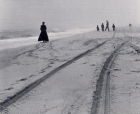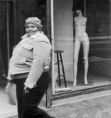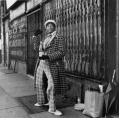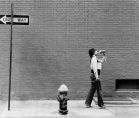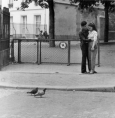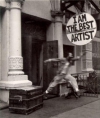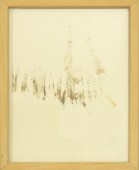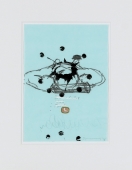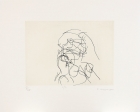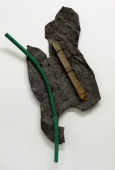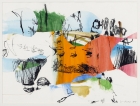
Artist | Victor Macarol
https://www.artist-info.com/artist/Victor-Macarol
Biography
Biography
Multimedia artist from New Jersey, Victor Macarol, completed his postgraduate studies at The Peabody Institute of Johns Hopkins University in Baltimore, Maryland.
Victor Macarol's works have been displayed in one-man exhibitions at The New Jersey State Museum in Trenton, Hunterdon Museum of Art in Clinton, MCC College in Edison, Goldsmiths Gallery in Lambertville, New Jersey; St. Joseph's University Gallery in Philadelphia, Pennsylvania; Galerie FOMA in Hradec Králové, Czech Republic; Gallery at Cankarjev dom in Ljubljana, Slovenia; Galerie du Photographe in Paris, France; Galerie 147 in Basel, Galerie Mesmer in Basel, Galerie Zur Stockeregg in Zurich, Switzerland; Galerie Michel Ray in Paris, France.
His participation in other exhibitions also includes "Images of the Flatiron Building" at Berry-Hill Gallery, "11th Annual Art Expo NY" at the Jacob K. Javits Center, "Portraits" at Cork Gallery of The Lincoln Center for the Performing Arts, and "The Thirteen Collection" - a preview exhibition of selected artworks for auction at Sotheby's in New York City; the "Fourth Biennial: New Jersey Artists" at The New Jersey State Museum in Trenton, "The Fellowship Awards Winners" at The Monmouth Museum in Lincroft, "Photography: A Personal View" at The Morris Museum in Morristown, New Jersey; "Portrait" at Benteler Galleries, Inc. in Houston, Texas; "Five Years of Collecting Photographs" at The Museum of Modern Art in Ljubljana, Slovenia; "Man, Focus, Place" at Galerie Arté in Basel, "Traces" at Galerie Mesmer in Basel, "Black on White" at Galerie Mesmer in Basel, and "Twentieth Century American Photographers" at Galerie Zur Stockeregg in Zurich, Switzerland.
NJN TV channels #23, #50 #52 and #58 (Trenton, NJ) on the program "State of the Arts," WNEW TV Channel #13 (NJ/NYC) on the program "Art Scene in New Jersey," GATEWAY CABLE TV Channel #3 (Newark, NJ) on the program "Exposure," and CTN (Cable TV Network of New Jersey) on the program "Monthly Show on the Arts in Middlesex County and Central New Jersey" have frequently been spotlighting interviews with Victor Macarol and presentations of his works.
Limited editions of museum posters, lithographs and art-postcards by Victor Macarol have been published in Switzerland, Italy and Holland under the aegis of Musée de l'Elysée in Lausanne, Switzerland. These works are available in Austria, Belgium, Canada, Denmark, Finland, France, Germany, Greece, Holland, Israel, Italy, Japan, Norway, Portugal, Spain, Sweden, Switzerland, United Kingdom, and the United States. They are/were displayed in various institutions, such as: MJM Art Gallery and French Kisses in New York City; Devon Editions in Seattle, WA; Centre National d'Art et de Culture Georges Pompidou in Paris and Espace Aleph, Entrée des Artistes in Paris, France; Antiquariat-Bücher in Vienna, Austria; Plakatif Galerie, Galerie Chat Noir, Jäggi Buch-Handlung in Basel, Buch-Handlung Payot in Zurich, Musée de l'Elysée in Lausanne, Switzerland; Art Print Japan Co., Ltd. in Tokyo.
Victor Macarol's works are in permanent art collections of The New Jersey State Museum in Trenton, Jane Voorhees Zimmerli Art Museum in New Brunswick, and The Noyes Museum in Oceanville, New Jersey; Bibliothèque nationale de France in Paris; Kunsthaus in Zurich, and Musée de l'Elysée in Lausanne, Switzerland.
Awards and honors came to Victor Macarol in plenty, including The New Jersey State Council on the Arts' Distinguished Artist Award "...In recognition of [his] exceptional artistic merit and...contribution towards improvement of the quality of the cultural life of the State of New Jersey."
Victor Macarol is listed in Who's Who in American Art.
About the work
About the work
IMPROMPTU ENCOUNTERS
A disguised overweight young woman walks past a shop window where a forgotten slender nude mannequin is casting her frozen invitation. A little further down the street, still in New York City, an elderly black man raises his fist while, behind him, a wall painting showing Christ promises Peace. On the other side of the Atlantic, a street singer bawls out on the square in front of the Musée de I'Art Modeme, but this doesn't bother the young couple who are so obviously in love, and a good-natured pigeon lingers aimlessly at the foot of an ancient statue in the Jardin des Tuileries. It seems that each time such an encounter occurs, Victor Macarol is nearby and ready: the shutter is released and the magic of the moment is preserved in black and white and in two dimensions. A poet, always alert and aware of these brief and contrasting encounters, Victor Macarol transforms them into veritable icons.
The geometry of urban architecture provides the foundation for his compositions: the rhythm of a stairway, the vertical line of a shade, the shape of the image placed inside the framework of a window. An old woman smiles at her tiny dog, another confides secrets to a friend. Each detail of the setting adds its unique perspective to the encounter. Contrasting with the transience of the moment, the stability of the background gives a sense of tranquility, of a place removed from the bustle of the everyday world. The proof: only children, elderly, tramps and lovers are there, idling away their time. The characters in Macarol's pictures are simply enjoying the fresh air or the sun, chatting quietly or just dreaming. Beside them are dogs, cats and pigeons doing much of the same thing, striking almost human attitudes that reveal a state of complete domestication.
Signs and placards abound in Macarol's world. Dynamic and expressive, they also play the role of legends and at the same time help to create contradictions: here, a man is walking in the opposite direction to that of the arrow of the "One way only" sign; there, a dog with long white tousled hair sits under a sign saying "Polyester and Cotton." The outcome is gentle and poetic.
There is nothing grandiose about this truly subtle work: no ambitious vistas, no distant horizons or eternal snows. It goes to the very heart of the most ordinary moments in the everyday lives of Macarol's people, and seems to fan the wonderful sparks created by the interplay between his unwitting accomplices.
Just like a painting by René Magritte or a poem by Jacques Prévert, the emotional appeal of a photograph by Victor Macarol is universal. No anecdotes, no archetypes. The symbols in his silver prints speak clearly around the world, without need of explanation.
Always enchanted by what he sees in the heart of the gray concrete jungle of our sprawling cities, Macarol never tires of seeking out and discovering those small amusing and charming corners where logic is defied - the ballads of impromptu encounters.
Françoise Monnin
Paris, October 1992
Françoise Monnin, D.E.A. Contemporary Art, Sorbonne, Paris. Art Historian and editor for the magazine Muséart.
AN EXERCISE IN AESTHETICS
I first met Victor Macarol when I interviewed him for a book I was writing several years ago. The book had nothing to do with photography, so what a happy occurrence that, through coming to know the man, I came to know his art as well.
In fact, now that I know his art, by contrast I may know Macarol less. His art is so full of possibilities, it is such a shifting kaleidoscope of images and meanings that it is difficult to discern the "real" Macarol. Is Macarol serious? Yes, but. Is he humorous? Yes, but. Is lie profound? Yes.
Macarol's work is full of improbabilities; he has a love for the accidental. Macarol finds significance in the conflicts of life - down and out people, down and out dogs, down and out buildings. Life is wonderful and crazy in Macarol's world. In fact, it is wonderful because it is crazy.
Not that Macarol editorializes. His pictures are not sentimental; there is no radical chic here. They force us to see beauty in the most unexpected places, but there is no sociological spillover.
They are also not reformist. Macarol is not engaging our sympathies in behalf of a cause. The people he portrays are neither better nor worse than anyone else. They are not alienated. They just are.
Which is why Macarol's street scenes, whether in New York or elsewhere have a common quality. They are all part of an exercise in aesthetics.
Take the picture "Counterpoint." There is the curve of the boy's back, the reverse curve of the black standpipe, and, finally, the alternating curve of the white drainpipe. Is this picture of a boy or of something else entirely?
Take the bum lying next to the steps in the picture "Legs." He is not being celebrated. Nor does the picture wish to lift him out of his supposed misery. In a sense, the picture is not about hirn; it is about the architectural character of his legs. Those are not legs at all; they are a Brancusi sculpture.
Of course, the foreshortening of the legs, the huge feet, and the absence of a head also give the picture that comic quality which is always peeking around the comer in Macarol's work. This is not a humor designed to produce a guffaw. Macarol does not engage in one-liners. Rather, the humor is ironic; it is inherent in the aesthetic composition of the work. Thus, the viewer is free to laugh or not as he chooses or even to be sad. Or both.
For Macarol, humor is a serious business. No accident, then, that his favorite writers are James Thurber and Isaac Bashevis Singer. What these writers share is that their primary interest is not in humor at all but in art. To put it another way, what animates them, and what animates Macarol, is ambiguity.
The reason we look at a Macarol picture - and look at it again - and sometimes again - is that it is saying a lot of different things at once. It says one thing, and then another, and then, perhaps, a third but the key thing is that, ultimately, it says them simultaneously. Macarol's great talent is in being able to present all of this juxtaposition unresolved, like a chemical solution in which the original ingredients are so thoroughly mixed they cannot separate out; they are not even readily discernible.
Macarol's work helps us to see that photography is not primarily about depicting life as it is but as it might be, that, like painting, what photography is ultimately about is itself. In the present ferment Macarol's work is particularly instructive. The people in his photographs are the most ordinary one might find anywhere, but lie invests them with extraordinary possibilities. Macarol is like a painter who consciously limits his palette so that the contrast between what is there to the undisceming eye and what Macarol reveals to us is all the greater. Thus his predilection for finding the little nooks and crannies of life where, in one human gesture, or in one minor architectural feature, a whole story or novel is conu-nunicated.
And yet, if Macarol is adept at communicating what is called a "slice of life," it is always the universal qualities of his pictures which remain with one. Again,- not because of their sociological or historical qualities but their aesthetic ones. Time and place stop and are replaced by abstract forms. It is Macarol's ability to give us both - the particular and the universal - which is the hallmark of his art.
Dr. Michael A. Rockland
Chairman, American Studies Department
Rutgers, The State University of New Jersey
FASCINATING PAIRINGS OF SUBJECTS
Perhaps what delights me most about Victor Macarol's works are the fascinating pairings of subjects which he discovers in the most ordinary of circumstances; they seem to exist (and in a moment will cease existing in that same state) entirely by accident. These pairings often skirt between jest and drama. They are multilayered in that the viewer can conjure up several reasons as to why these particular subjects should have been juxtaposed, without ever being certain of the correct reason, or whether there is, in fact, a single explanation.
For instance, consider the cat on New York's Thompson Street seated upon a stepladder next to a window out of which a large poster-photo of Marilyn Monroe faces us. First we notice that the postures of the cat and the woman, both with legs extended from the torso, are similar. The seated feline possesses the potential for lithe movement, as does the image of Monroe. They both seem unaware of their own seductiveness, whether furry or fleshy, and, if the cat is smaller than the woman, the legs of the ladder, as extenders, make the cat appear closer in size to the pictured woman.
It is marvelous that so many of the photographs remain as open-ended as they do in a number of possible ways they can be interpreted. On a Paris street Macarol photographed a dog playfully rolling on its back next to an old woman using an umbrella as a cane. Is it the dog beside her which highlights the contrast between their inabilities to move freely? Or perhaps its legs as four extenders echo the woman with two legs who holds her umbrella as an extra extender?
For some reason, Macarol is fascinated by dogs, not only by the lithe greyhound variety, not only by the fierce wolf-hound variety, but also by the short, homely, rather ordinary variety. One such dog, caught in a car on Bleecker Street in New York, has comically taken the place of the driver, its absent master. Another such dog, in a parked car on East 7th Street, again in New York, is presented with its face distorted by the window glass standing between it and the viewer. This dog becornes devilish and sinister and threatening, even while retaining, remarkably, the barest hint of the need to cuddle - again the open-ended possibility for interpretation.
Macarol's perceptiveness of what lie is trying to accomplish has to do with the discovery of relationships which exist momentarily within the life of the urban environment. In his work the purity and the harshness of reality coexist: much of the work has to do with a certain unique witticism which amuses the viewer at first until the real meaning it represents or masks is realized. Macarol's is a vision to be savored.
Dr. Abraham A. Davidson
Department of Art History
Tyler School of Art, Temple University
Philadelphia, Pennsvlvania
 offers / Requests offers / Requests  |
About this service |
|---|
 Exhibition Announcements Exhibition Announcements  |
About this service |
|---|
 Visualization |
Learn more about this service | ||
|---|---|---|---|

Interested in discovering more of this artist's networks?
3 easy steps: Register, buy a package for a visualization, select the artist.
See examples how visualization looks like for an artist, a curator, or an exhibition place: Gallery, museum, non-profit place, or collector.

Exhibition History

|
SUMMARY based on artist-info records. More details and Visualizing Art Networks on demand. Venue types: Gallery / Museum / Non-Profit / Collector |
||||||||||||
| Exhibitions in artist-info | 5 (S 3/ G 2) |
Did show together with - Top 5 of 6 artists (no. of shows) - all shows - Top 100
|
||||||||||
| Exhibitions by type | 5: 5 / 0 / 0 / 0 | |||||||||||
| Venues by type | 3: 3 / 0 / 0 / 0 | |||||||||||
| Curators | 0 | |||||||||||
| artist-info records | Mar 1998 - Jun 2001 | |||||||||||
|
Countries - Top 3 of 3 Switzerland (2) United States (2) France (1) |
Cities 3 - Top of 3 Basel (2) Lambertville (2) Paris (1) |
Venues (no. of shows )
Top 3 of 3
|
||||||||||
|
Curators (no. of shows)
Top 0 of 0 |
| Galerie Michel Ray | S | Jun 2001 - Jun 2001 | Paris | (1) | +0 | |
| Goldsmiths Gallery | S | Apr 2001 - Apr 2001 | Lambertville | (2) | +0 | |
| Goldsmiths Gallery | S | Apr 2000 - Jun 2000 | Lambertville | (2) | +0 | |
| Galerie Mesmer | G | Apr 1999 - Jun 1999 | Basel | (39) | +0 | |
| Galerie Mesmer | G | Mar 1998 - Apr 1998 | Basel | (39) | +0 | |
| Keep reading |











